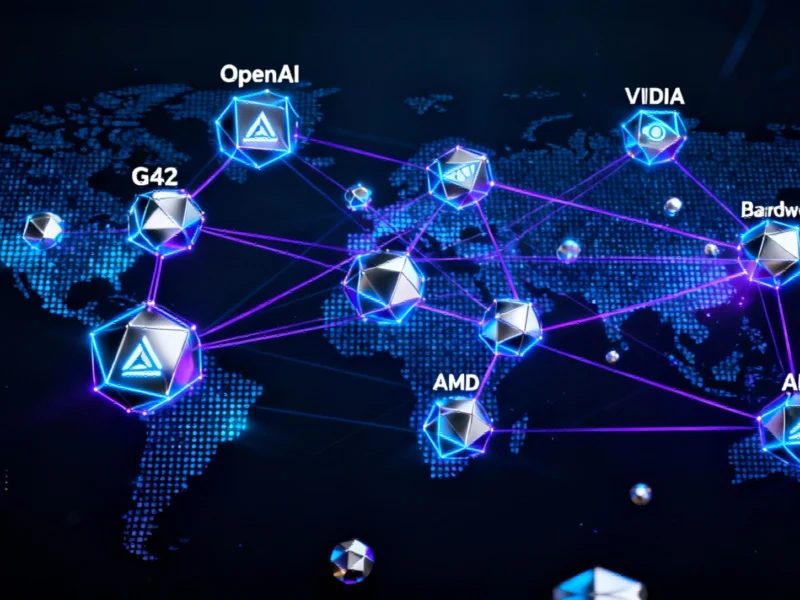Strategic Partnerships Fuel Unprecedented AI Infrastructure Expansion
OpenAI is rapidly constructing what industry analysts are calling the most ambitious artificial intelligence infrastructure network in history, with recent partnerships and agreements totaling over $1 trillion in combined value. This massive expansion, detailed in recent infrastructure analysis, represents a fundamental shift in how AI capabilities will be developed and deployed globally.
The scale of this undertaking became clearer following discussions between OpenAI CEO Sam Altman and G42’s Peng Xiao at GITEX Global 2025 in Dubai, where they outlined their collaborative vision for AI infrastructure, chip design, and international cooperation. Peng emphasized the necessity of partnership, stating, “No company and no individual can do this alone, and that’s why we’re here sharing the stage with Sam as an equitable partner.”
Broadcom Partnership Marks Critical Infrastructure Milestone
OpenAI’s most recent strategic move involves a groundbreaking agreement with Broadcom to co-develop custom AI chips. The partnership will deploy enough processors to consume 10 gigawatts of electricity in the second half of next year, representing one of the largest single infrastructure commitments in computing history.
“Partnering with Broadcom is a critical step in building the infrastructure needed to unlock AI’s potential and deliver real benefits for people and businesses,” Altman stated. “Developing our own accelerators adds to the broader ecosystem of partners all building the capacity required to push the frontier of AI to provide benefits to all humanity.”
Broadcom CEO Hock Tan expressed equal enthusiasm, calling the collaboration “a pivotal moment in the pursuit of artificial general intelligence.” He added, “We are thrilled to co-develop and deploy 10 gigawatts of next-generation accelerators and network systems to pave the way for the future of AI.”
Trillion-Dollar Network Reveals Comprehensive Strategy
The full scope of OpenAI’s infrastructure ambitions was visualized in an image shared by StockMarket.News, depicting what they described as “the most expensive AI infrastructure network in history.” The network includes several monumental components:
- Stargate UAE: A $500 billion public-private project involving the U.S. government, Oracle, and SoftBank
- Nvidia Partnership: $100 billion supply deal for tens of thousands of GPUs
- Microsoft Alliance: $13 billion Azure cloud partnership
- AMD Collaboration: Potential $100 billion agreement for 6 gigawatts of next-generation chips
This expansion comes amid broader industry shifts, including regulatory challenges facing major tech companies and workforce restructuring across the technology sector.
Circular Financing Model Underpins Growth Strategy
Industry analysts have identified what they term a “circular financing” model driving OpenAI’s expansion. In this ecosystem, GPU vendors provide funding to OpenAI, which in turn drives demand for their products, creating a mutually beneficial economic cycle. This approach has enabled OpenAI to establish control across every layer of the AI supply chain, from semiconductor design to cloud infrastructure and energy management.
The company’s valuation has now surpassed $500 billion, with its growth trajectory closely linked to nearly $3 trillion in expected data center spending through 2028. Remarkably, approximately $800 billion of this investment is being financed through private credit markets, indicating strong investor confidence in AI infrastructure.
This massive infrastructure push aligns with broader industry trends, including significant venture capital investments in blockchain infrastructure that demonstrate continued confidence in next-generation computing technologies.
Sustainability Questions Loom Over Massive Energy Requirements
While the technical and financial achievements are impressive, the energy requirements of OpenAI’s expanding infrastructure raise important questions about long-term sustainability. The 10 gigawatts of electricity consumption from the Broadcom partnership alone represents approximately the output of 10 nuclear power plants, highlighting the enormous energy demands of advanced AI systems.
Industry observers are beginning to question how long this aggressive expansion model can be sustained. As one analysis noted, “How long can this model last before the money runs thin?” This question becomes increasingly relevant as the scale of investment continues to grow and the energy requirements become more substantial.
Despite these concerns, OpenAI’s infrastructure network represents a watershed moment in artificial intelligence development, establishing new benchmarks for partnership models, investment scale, and technological ambition in the AI industry.
Based on reporting by {‘uri’: ‘techradar.com’, ‘dataType’: ‘news’, ‘title’: ‘TechRadar’, ‘description’: ”, ‘location’: {‘type’: ‘country’, ‘geoNamesId’: ‘2635167’, ‘label’: {‘eng’: ‘United Kingdom’}, ‘population’: 62348447, ‘lat’: 54.75844, ‘long’: -2.69531, ‘area’: 244820, ‘continent’: ‘Europe’}, ‘locationValidated’: False, ‘ranking’: {‘importanceRank’: 159709, ‘alexaGlobalRank’: 1056, ‘alexaCountryRank’: 619}}. This article aggregates information from publicly available sources. All trademarks and copyrights belong to their respective owners.



